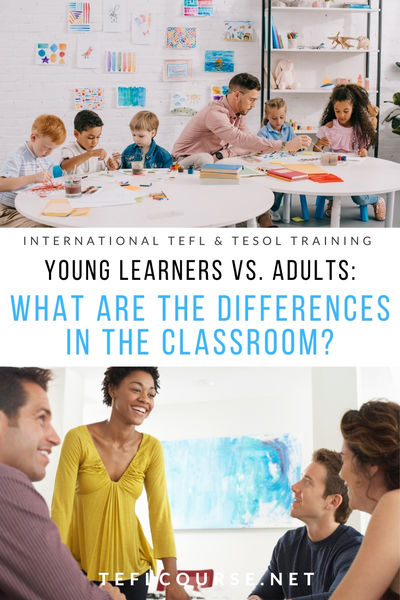Young Learners vs. Adults: What are the Differences in the Classroom?

Learning a new language is not an easy task, regardless of the age it is learned at, and with the globalization of the English language, there are more and more people faced with the challenge of learning English to better their lives. English is known as one of the most difficult languages to learn due to its irregularities, and therefore requires a variety of different techniques to be applied in the classroom to help students learn the language better. Even though adult and young learners are both learning the same things, the learning process for both groups can be quite different.
Table of Contents
Do you want to teach English abroad? Take a TEFL course!
This post was written by our TEFL certification graduate Melanie D. Please note that this blog post might not necessarily represent the beliefs or opinions of ITTT.
Working with young students
In a young learner's classroom, it is common to use many physical activities, games and visual aids. In a classroom with a younger age group, learning is more successful if the students have fun learning the concepts. The use of songs is also common in a young learner's classroom, as it uses repetition to help their memory with concepts. For example, the use of a tidy up song explaining where everything goes is useful as it teaches students common names of objects, as well as reminds them when they hear the melody to begin to tidy things where they should go. The use of visual aids in a young learner's classroom is also imperative as it introduces new vocabulary in a way that can be directly associate in their minds with their native language to allow connections to be made. The use of games in a young learner's classroom is especially important to use in a young learner's classroom because it allows the students to get up and move, as well as have some fun while learning.
In a young learner's classroom, it is important to remember to make activities shorter and to switch things up often to reduce the possibility of students becoming bored in the classroom. This will also reduce the chances of students being disruptive, as they will be occupied with activities. The use of games is helpful because it allows for a fun change in the classroom, and using a physical game can help the students get some of their bursts of energy out.

Also Read: What is the EPIK program for teaching English in South Korea?
Working with adults
In an adult learner's classroom, it is much more common to use activities that are not as physical or energetic as those used in a young learner's classroom. This is due to different maturity levels; as well as adult learners typically do not need as much stimulation to remain focused in the lesson. However, the use of visual aids and games is still helpful in the classroom. As mentioned previously, the learning process is more successful for students if they had fun learning concepts. However, in an adult classroom, the games would be a little more "sophisticated" instead of physical like they would be in a young learner's classroom. In an adult classroom, the use of visual aids such as menus from restaurants is interesting to students as it is real-world experience and the students feel motivated to learn because it is almost like a "real world" experience. The use of repetition techniques is also still important in this learning environment, however, instead of using songs it could be based as a drilling exercise instead.
Do you want to teach English abroad? Take a TEFL course!
In either classroom, it is important to incorporate activities that each group of students would enjoy, to ensure a successful learning environment. Many different resources can be used in the classroom to make things more fun and interesting for different age groups. Although they are very different age groups and learning environments, they are still learning the same concepts and lessons can be adjusted to the age group required.
Apply now & get certified to teach english abroad!
Speak with an ITTT advisor today to put together your personal plan for teaching English abroad.
Send us an email or call us toll-free at 1-800-490-0531 to speak with an ITTT advisor today.
Related Articles:
- Top TEFL Countries That Hire Teachers in Advance
- 5 Reasons Why Teaching Abroad is Better Than Studying Abroad
- The 10 Best Destinations for Teaching English Abroad in 2018
- Why You Should Take Specialized TEFL Courses
- You're Never Too Old to Change Your Life and Do a TEFL Course
- All the Documents You Will Need to Teach English Abroad




